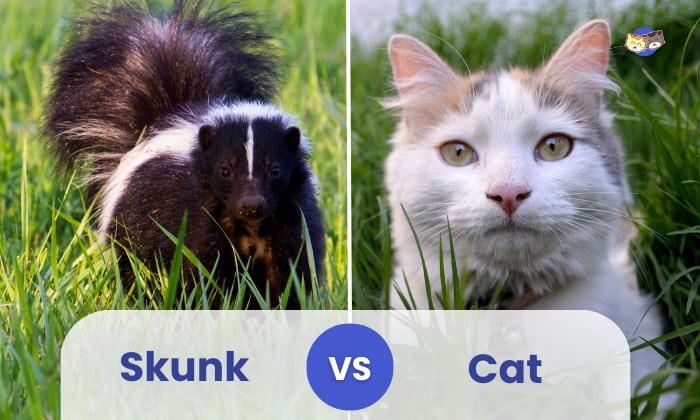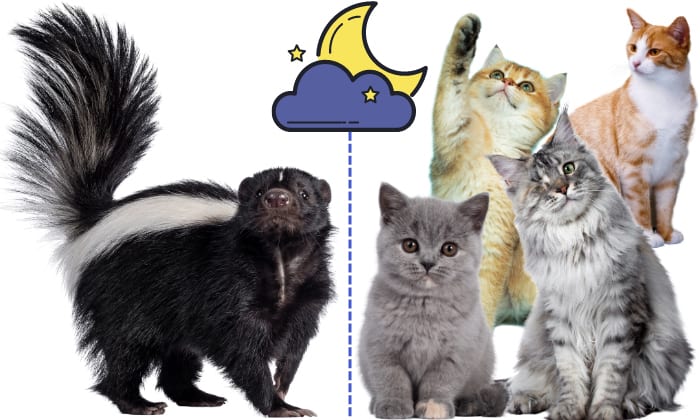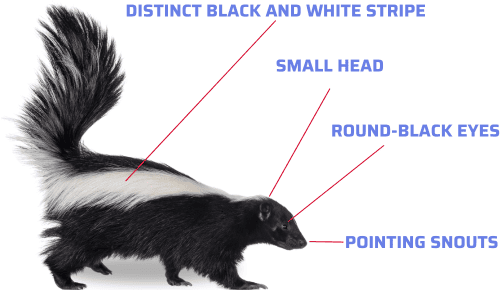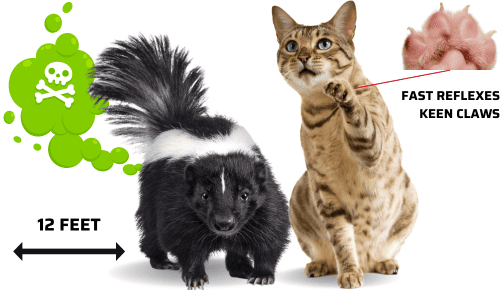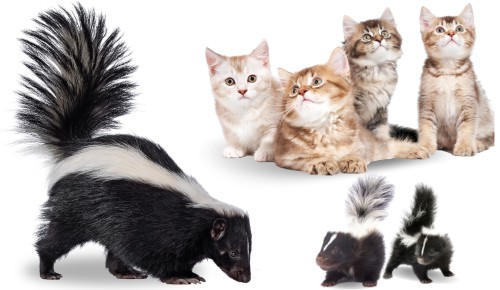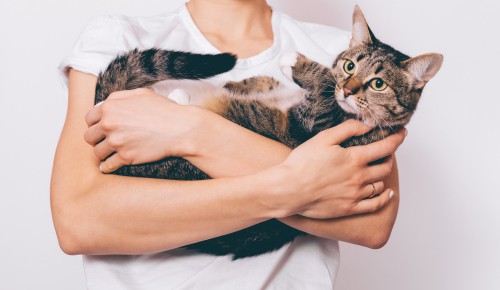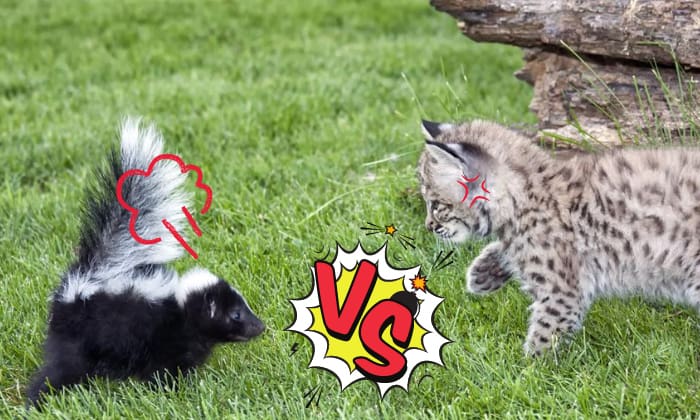The world of animals is an intriguing one, full of varied and even surprising relationships. The interactions between skunks and cats stand out among these relationships as being unusual and occasionally contentious.
In this article, we compare these two species—skunk vs cat—and examine their unique traits, potential conflicts, and the unexpected ways that their cohabitation affects ecosystems.
To give you an insight, here’s a comparison table.
| Aspect | Skunk | Cat |
| Appearance | Striped with distinct odor | Graceful and varied breed |
| Average Length | 20 – 30 inches ( 50 – 80 cm) | 18 – 20 inches (46 – 50 cm) |
| Average Weight | 5 – 7.5 lbs (2.5 – 3.5 kg) | 9.5 – 11 lbs (4 – 5 kg) |
| Defense Mechanism | Spray potent odor | Sharp claws and agility |
| Nocturnal Behavior | Active at night | Active both day and night |
| Predatory Instinct | Omnivorous | Carnivorous hunter |
| Interaction | Usually avoid confrontation with cats | May chase or be chased by skunks |
Table of Contents
About Skunks and Cats
Skunk
Skunks are nocturnal animals that primarily seek insects, rodents, as well as plants. They are distinguished by their characteristic black and white stripes and their strong spray. A crucial survival adaptation is their notorious defense mechanism, a pungent-smelling spray.
Cat
On the other hand, cats are adept hunters due to their predatory instinct and a vast range of breeds and sizes.
Differences Between Cat vs Skunk
From the skunk’s defense system to cat’s behavioral traits, these two species display an amazing range of contrasts that influence their functions in the natural world.
1. Physical characteristics
Skunks can be identified by their distinct black and white stripe, with the white color running on their back to the long tail. You can easily notice them with their pointing snouts, round-black eyes and a small head compared to their body.
In contrast, cats come in a wide variety of breeds, from the sleek Siamese to the fluffy Persian, each having distinctive physical characteristics, coat patterns, and colors.
2. Defense mechanisms
Skunks have specialized anal scent glands that discharge a potent scent that lasts for days as a deterrent to predators. Notably, they can spray this grand as far as 12 feet and sting the enemy in the eyes.
Cats, on the other hand, spray as a stress relief and self-assurance method, not to defense themselves. When facing major threats, they often withdraw or freeze, then crouch down for self-protection. In a fight, they rely on their agility, fast reflexes, and keen claws for defense, frequently hissing and arching to scare predators.
3. Nocturnal behavior
Skunks are typically nocturnal animals that hunt for food at night while evading predators during the day, utilizing their excellent sense of smell. However, they won’t be too active at night during the cold winter.
Cats, conversely, engage in crepuscular behavior and are most active around dawn and dusk to correspond with their innate hunting instincts.
4. Diet and feeding habits
As omnivores, skunks eat various things, including plants, small mammals, insects, and bird eggs. They also love fruit, bird seeds, and nuts and might scavenge your garbage to find food.
Cats, on the other hand, are obligate carnivores and need a diet rich in animal protein. They are also skilled hunters who like to take down small mammals and birds.
5. Social structure and behavior
Beyond the breeding season, skunks are mostly solitary creatures with little social interaction.
Cats, on the other hand, display a variety of social behaviors, from being solitary to building colonies, and they are capable of developing close relationships with both people and other cats.
6. Interaction with humans
Skunks are sometimes considered pests because of the possibility of odor-related encounters with people and animals. However, they are not very aggressive or trying to hurt people on purpose.
Cats, on the other hand, have been domesticated for thousands of years, developing intimate bonds with people as pets and exhibiting a wide range of behaviours and personalities based on breeds and personal experiences.
Who Would Win in a Fight?
The result of a hypothetical fight between a skunk and a cat would depend on a number of variables.
Even though some potential predators are scared when sprayed by skunks, many cats are wary of it since they strongly dislike the smell. Skunks would avoid confrontations directly due to their amiable character. Still, cats might have an advantage in a physical battle due to their hunting abilities and agility.
Can a cat kill a skunk? That’s very rare to happen; that’s why while a cat’s hunting prowess could give it an advantage in a physical encounter, skunks’ defensive spray often deters such confrontations. Also, most of the time, cats scare away skunks, thus eliminating extended interactions.
This encounter has captured the attention of Quora members, who are actively discussing it and seeking answers. Get involved in the discussion here.
Preventing Skunk Attacks on Cats
Are skunks dangerous to cats? Definitely, that’s why skunk-cat fights could occur, which worries pet owners. To guarantee both animals’ welfare and safety, such confrontations must be avoided. Here are some successful tactics and skunk deterrents:
- Secure Waste Bins
Skunks are drawn to food sources that are simple to get to. To prevent skunks from scavenging, make sure trash cans are shut tightly.
- Remove Food Sources
Skunks are attracted to bird feeders and rotting food. Keep these locations regularly clean to get rid of potential food sources. It would help to hang the bird feeders and baths high from the ground.
- Use Motion-Activated Lights
Skunks are nocturnal animals that avoid brightly illuminated locations. Skunks might be deterred from visiting your home by using motion-activated lights.
- Install Barriers
Skunks can’t dig under your yard if a piece of your fence is buried underneath.
- Avoid Attractive Scents
Pet food and compost are two odors that attract skunks. Keep these things in airtight containers.
- Use Repellents
Skunks can be deterred from approaching your home using organic deterrents like citrus peels or rags soaked in ammonia.
- Keep Pets Indoors
Keeping your cats indoors might help avoid potential conflicts, particularly at night when skunks are active.
Conclusion
A fascinating illustration of the complex relationships seen in the animal realm is the link between skunks and cats. Skunk vs cat may occasionally happen, although interactions between the two are often characterised by avoidance rather than combat.
Peaceful coexistence can be promoted by being aware of the distinctions between these organisms and taking preventative actions. We may protect our pets and appreciate the variety of life around us by appreciating the special characteristics of skunks and cats.
Read next:

I am Amy Sawy, a Doctor of Veterinary Medicine (DVM) graduate from the University of Kansas. y husband, Dr. Plummer, and I own a veterinary clinic in Phillipsburg, Kansas. In addition to my professional background, I am a devoted pet owner myself, with a household that includes dogs, rodents, and most notably, cats – a total of five felines in my home.
In 2020, I joined an organization as a professional writer, leveraging my experience and collaborating with my team to deliver the most valuable information for your cat’s care.


